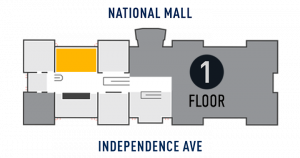Following the September 1967 commitment of corporate funds to develop the engine, the General Electric CF6-6 turbofan was selected in April 1968 to power the McDonnell Douglas DC-10 Series 10 intermediate-range transport aircraft then on order by United Air Lines and American Airlines. This was GE's first major turbofan engine for commercial aviation, and was derived from the company's large TF-39 turbofan that powered the Lockheed C-5A. FAA certification was obtained in September 1970, and airline service began in August 1971.
Construction of the CF6 is modular to facilitate easily removable, interchangeable components that allow airlines to minimize spare-parts holdings and to use sectional overhaul procedures.
The CF6 engine family has a power range of up to 313 KN (72,000 lb) of thrust, and powers other aircraft including the Boeing 747 and 767, McDonnell Douglas MD-11, and Airbus Industrie A300, A310 and A330.
The artifact is displayed in a simulated engine test cell.
Display Status
This object is on display in America by Air at the National Air and Space Museum in Washington, DC.

Object Details
Date
1969
Country of Origin
United States of America
Type
PROPULSION-Turbines (Jet)
Manufacturer
General Electric Aircraft Engines
Physical Description
Type: Turbofan
Thrust: 178,000 N (40,000 lb) at 3,810 rpm
Compressor: Single-stage fan, single-stage axial low pressure, 16-stage axial high pressure
Combustor: Annular
Turbine: 2-stage axial high pressure, 5-stage axial low pressure
Weight: 3,379 kg (7,450 lb)
Dimensions
3-D: 574 × 251.5 × 271.8cm, 3379.3kg (18 ft. 10 in. × 8 ft. 3 in. × 8 ft. 11 in., 7450lb.)
Support: 231.1 × 365.8 × 243.8cm (7 ft. 7 in. × 12 ft. × 8 ft.)
Materials
Metal
Inventory Number
A19772557000
Credit Line
Gift of Aircraft Engine Business Group, General Electric Company
Data Source
National Air and Space Museum
Restrictions & Rights
Usage conditions apply
For more information, visit the Smithsonians Terms of Use.